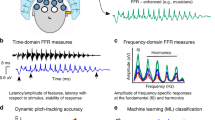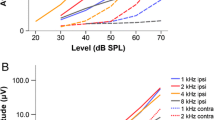Abstract
The auditory brainstem response (ABR) is relatively non-invasive, and in many species, the only practical way to assess auditory sensitivity. The two main methods for measuring ABR are using either transients or tone bursts as a stimulus. The transient stimulus produces strong neural responses that contain no frequency information. In contrast, tone bursts stimulate only a small part of the auditory system, eliciting weaker neural responses but supplying frequency information. Furthermore, short tone bursts become less and less frequency specific with increasing stimulus wavelength, making them unsuitable for testing low-frequency hearing. Here, we develop a method that can measure sensitivity to both low and high-frequency stimuli. The method is based on masking of a transient response by long-duration sinusoids. The measurement system is developed as a highly portable system that runs on battery power. It has been used in a variety of animals in our lab and in the field, including squid (Mooney et al. in J Exp Biol 213: 3748–3759, 2010), lungfish (Christensen-Dalsgaard et al. in J Neurophys 105: 1992–2004, 2011b), alligators (Bierman et al. in J Exp Biol 217: 1094–1107, 2014), and mink (Brandt et al. in J Exp Biol 216: 3542–3550, 2013). Here, we present data recorded from Tokay geckos and compare the results with tone burst ABR measurements. This method produces results comparable to tone burst stimulations at higher frequencies (above 1 kHz) but has several advantages: it is relatively insensitive to fluctuations in neural signal level, it allows measurements at very low frequencies, it allows constant monitoring of the state of the animal, and can be used to measure directional hearing.







Similar content being viewed by others
References
Berlin CI, Hood LJ, Barlow EK, Morehouse CR, Smith EG (1991) Derived guinea pig compound VIIIth nerve action potentials to continuous pure tones. Hear Res 52:271–280
Bierman HS, Thornton JL, Jones HG, Koka K, Young BA, Brandt C, Christensen-Dalsgaard J, Carr CE, Tollin DJ (2014) Biophysics of directional hearing in the American alligator (Alligator mississippiensis). J Exp Biol 217:1094–1107
Brandt C, Andersen T, Christensen-Dalsgaard J (2008) Demonstration of a portable system for auditory brain stem recordings based on pure tone masking difference. In: Dau T, Buchholz JM, Harte JM, Christiansen TU (eds) Auditory signal processing in hearing-impaired listeners. 1st International symposium on auditory and audiological research. Centertryk, Copenhagen, pp 241–247
Brandt C, Malmkvist J, Nielsen RL, Brande-Lavridsen N, Surlykke A (2013) Development of vocalization and hearing in American mink (Neovison vison). J Exp Biol 216:3542–3550
Brittan-Powell EF, Dooling RJ, Gleich O (2002) Auditory brainstem responses in adult budgerigars (Melopsittacus undulatus). J Acoust Soc Am 112:999–1008
Brittan-Powell E, Christensen-Dalsgaard J, Tang Y, Carr CE, Dooling R (2010) The auditory brainstem response in lizards. J Acoust Soc Am 128:787–794
Burkard RF, Don M (1997) The auditory brainstem response. In: Burkard RF, Don M, Eggermont JJ (eds) Auditory evoked potentials. Basic principles and clinical applications. Lippincott Williams &Wilkins, Philadelphia, pp 229–253
Christensen-Dalsgaard J, Manley GA (2013) The malleable middle ear: an underappreciated player in the evolution of hearing in vertebrates. In: Köppl C, Manley GA, Fay RR, Popper A (eds) Insights from comparative hearing research. Springer Handbook of Auditory Research. Springer, New York, pp 157–191
Christensen-Dalsgaard J, Brandt C, Wilson M, Wahlberg M, Madsen PT (2011a) Hearing in the African lungfish, Protopterus annectens. Preadaptations for pressure hearing in tetrapods? Biol Lett 7:139–141
Christensen-Dalsgaard J, Tang YZ, Carr CE (2011b) Binaural processing by the gecko auditory periphery. J Neurophys 105:1992–2004
Christensen-Dalsgaard J, Brandt C, Willis KL, Christensen CB, Ketten D, Edds-Walton P, Fay RR, Madsen PT & Carr CE (2012) specialization for underwater hearing by the tympanic middle ear of the turtle, Trachemys scripta elegans. Proc Roy Soc B 279: 2816–2824
Corwin JT, Bullock TH, Schweitzer J (1982) The auditory brain stem response in five vertebrate classes. Electroencephalogr Clin Neurophysiol 54:629–641
Don M, Ponton CW, Eggermont JJ, Masuda A (1993) Gender differences in cochlear response time: an explanation for gender amplitude differences in the unmasked auditory brainstem response. J Acoust Soc Am 94(4):2135–2148
Kodera K, Yamane H, Yamada O, Suzuki JI (1977) The effects of onset, offset, and rise-decay times of tone bursts on brain stem responses. Scand Audiol 6:205–210
Mooney TA, Hanlon RT, Christensen-Dalsgaard J, Madsen PT, Ketten DR, Nachtigall P (2010) Sound detection by the longfin squid (Loligo pealeii) studied with auditory evoked potentials: sensitivity to low-frequency particle motion and not pressure. J Exp Biol 213:3748–3759
Stapells DR, Oates P (1997) Estimation of pure-tone audiogram by the auditory brainstem response: a review. Audiol Neuro-Otol 2:257–280
Walsh EJ, Gorga M, McGee J (1992) Comparisons of the development of auditory brainstem response latencies between cats and humans. Hear Res 60:53–63
Funding
This study was supported by the Danish National Science Foundation [grant DFF1323-00132] and the Carlsberg Foundation grants to J.C.D.
Author information
Authors and Affiliations
Corresponding author
Ethics declarations
Conflict of Interest
The authors declare that they have no conflict of interest.
Rights and permissions
About this article
Cite this article
Brandt, C., Brande-Lavridsen, N. & Christensen-Dalsgaard, J. The Masked ABR (mABR): a New Measurement Method for the Auditory Brainstem Response. JARO 19, 753–761 (2018). https://doi.org/10.1007/s10162-018-00696-x
Received:
Accepted:
Published:
Issue Date:
DOI: https://doi.org/10.1007/s10162-018-00696-x




